
Concept explainers
(a)
Interpretation:
To analyze whether the given statement- There are two classes of
Concept Introduction:
Hydrocarbons consists of carbon atoms and hydrogen atoms. They are further classified as saturated or unsaturated on the basis that the hydrocarbon has all single bonds, or it involves double or triple bond also.
The hydrocarbon that has all single bond is called as
The hydrocarbon that has at least one double bond is called as alkene wit the general formula
The hydrocarbon that has at least one triple bond is called as alkyne wit the general formula
(a)
Answer to Problem 12.11P
There are two classes of unsaturated hydrocarbons-alkenes and alkynes. Thus, the statement is true.
Explanation of Solution
Hydrocarbons consists of carbon atoms and hydrogen atoms. They are further classified as saturated or unsaturated on the basis that the hydrocarbon has all single bonds or it involves double or triple bond also.
The hydrocarbon that has all single bond is called as alkane with the general formula
Example- Ethane
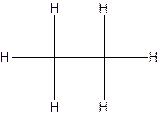
The hydrocarbon that has at least one double bond is called as alkene with the general formula
Example- Ethene
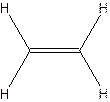
The hydrocarbon that has at least one triple bond is called as alkyne with the general formula
Example- Ethyene

Since all the bonds in alkenes and alkynes are not single bonds, they are unsaturated hydrocarbons
(b)
Interpretation:
To analyze whether the given statement- The bulk of the ethylene used by the chemical industry worldwide is obtained from renewable resources , is true or false.
Concept Introduction:
Ethylene is an unsaturated hydrocarbon, with the formula
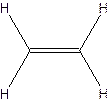
Renewable sources are those sources which when used once can be generated again.e.g. solar energy is a renewable source of energy.
Non-renewable sourcesare those sources which when used once are generated after millions of years e.g. coal and petroleum are non-renewable sources of energy.
The bulk of the ethylene used by the chemical industry worldwide is obtained from non-renewable resources. Thus, the statement is true.
There are several methods by which ethylene is extracted
- Steam Cracking of-
- Ethane and propane from natural gas or crude oil
- Naptha from crude oil
- Catalytic cracking of gas oil from crude oil
Crude oil and natural gas both are non-renewable sources. Therefore, the bulk of the ethylene used by the chemical industry worldwide is obtained from non-renewable resources
(c)
Interpretation:
To analyze whether the give statement- Ethylene and acetylene are constitutional isomers, is true or false.
Concept Introduction:
There are compounds which have same constituents but differ in the arrangement of atoms in space. The constitutional isomers are those compounds that have same molecular formula but different structural formula. For example- 2-Chloro butane and 1-Chloro butane are constitutional isomers.


2-Chlorobutane 1-Chlorobutane
Ethylene and acetylene are not constitutional isomers. Thus, the statement is false.
There are compounds which have same constituents but differ in the arrangement of atoms in space. The constitutional isomers are those compounds that have same molecular formula but different structural formula.
The molecular formula for ethylene
The structural formula for ethylene-
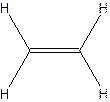
The molecular formula for acetylene
The structural formula for acetylene-
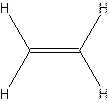
Since ethylene and acetylene neither have same molecular formula nor structural formula. So they are not constitutional formula.
(d)
Interpretation:
To analyze whether the give statement- Cyclohexane and 1-hexene are constitutional isomers, is true or false.
Concept Introduction:
There are compounds which have same constituents but differ in the arrangement of atoms in space. The constitutional isomers are those compounds that have same molecular formula but different structural formula. For example- 2-Chloro butane and 1-Chloro butane are constitutional isomers.


2-Chlorobutane 1-Chlorobutane
Cyclohexane and 1-hexene are constitutional isomers. Thus, the statement is true.
There are compounds which have same constituents but differ in the arrangement of atoms in space. The constitutional isomers are those compounds that have same molecular formula but different structural formula.
The molecular formula for Cyclohexane
The structural formula for Cyclohexane -

Cyclohexane
The molecular formula for 1-hexene
The structural formula for 1-hexene -

1-hexene
Since, cyclohexane and 1-hexene have same molecular formula and structural formula so, they are constitutional formula.
(b)
Answer to Problem 12.11P
The bulk of the ethylene used by the chemical industry worldwide is obtained from non-renewable resources. Thus, the statement is true.
Explanation of Solution
There are several methods by which ethylene is extracted
- Steam Cracking of-
- Ethane and propane from natural gas or crude oil
- Naptha from crude oil
- Catalytic cracking of gas oil from crude oil
Crude oil and natural gas both are non-renewable sources. Therefore, the bulk of the ethylene used by the chemical industry worldwide is obtained from non-renewable resources
(c)
Interpretation:
To analyze whether the give statement- Ethylene and acetylene are constitutional isomers, is true or false.
Concept Introduction:
There are compounds which have same constituents but differ in the arrangement of atoms in space. The constitutional isomers are those compounds that have same molecular formula but different structural formula. For example- 2-Chloro butane and 1-Chloro butane are constitutional isomers.


2-Chlorobutane 1-Chlorobutane
(c)
Answer to Problem 12.11P
Ethylene and acetylene are not constitutional isomers. Thus, the statement is false.
Explanation of Solution
There are compounds which have same constituents but differ in the arrangement of atoms in space. The constitutional isomers are those compounds that have same molecular formula but different structural formula.
The molecular formula for ethylene
The structural formula for ethylene-

The molecular formula for acetylene
The structural formula for acetylene-

Since ethylene and acetylene neither have same molecular formula nor structural formula. So they are not constitutional formula.
(d)
Interpretation:
To analyze whether the give statement- Cyclohexane and 1-hexene are constitutional isomers, is true or false.
Concept Introduction:
There are compounds which have same constituents but differ in the arrangement of atoms in space. The constitutional isomers are those compounds that have same molecular formula but different structural formula. For example- 2-Chloro butane and 1-Chloro butane are constitutional isomers.


2-Chlorobutane 1-Chlorobutane
(d)
Answer to Problem 12.11P
Cyclohexane and 1-hexene are constitutional isomers. Thus, the statement is true.
Explanation of Solution
There are compounds which have same constituents but differ in the arrangement of atoms in space. The constitutional isomers are those compounds that have same molecular formula but different structural formula.
The molecular formula for Cyclohexane
The structural formula for Cyclohexane -

Cyclohexane
The molecular formula for 1-hexene
The structural formula for 1-hexene -

1-hexene
Since, cyclohexane and 1-hexene have same molecular formula and structural formula so, they are constitutional formula.
Want to see more full solutions like this?
Chapter 12 Solutions
Introduction to General, Organic and Biochemistry
- Draw the skeletal ("line") structure of 2-hydroxy-4-methylpentanal. Click and drag to start drawing a structure. Xarrow_forwardDetermine whether the following molecule is a hemiacetal, acetal, or neither and select the appropriate box below. Also, highlight the hemiacetal or acetal carbon if there is one. hemiacetal acetal Oneither OHarrow_forwardWhat is the missing reactant R in this organic reaction? ་ ་ ་ ་ ་ ་ ་ ་ ་ ་ +R H3O+ • Draw the structure of R in the drawing area below. N • Be sure to use wedge and dash bonds if it's necessary to draw one particular enantiomer. Click and drag to start drawing a structure.arrow_forward
- Write the systematic name of each organic molecule: H structure H OH OH H OH name ☐ OHarrow_forwardDetermine whether each of the following molecules is a hemiacetal, acetal, or neither and select the appropriate box in the table. CH3O OH OH OH hemiacetal acetal neither hemiacetal acetal neither Xarrow_forwardWhat is the missing reactant R in this organic reaction? N N དལ་ད་་ + R • Draw the structure of R in the drawing area below. • Be sure to use wedge and dash bonds if it's necessary to draw one particular enantiomer. Click and drag to start drawing a structure. ㄖˋarrow_forward
- Draw the condensed structure of 4-hydroxy-3-methylbutanal. Click anywhere to draw the first atom of your structure.arrow_forwardUsing the bond energy values, calculate the energy that must be supplied or is released upon the polymerization of 755 monomers. If energy must be supplied, provide a positive number; if energy is released, provide a negative number. Hint: Avogadro’s number is 6.02 × 1023.arrow_forward-AG|F=2E|V 3. Before proceeding with this problem you may want to glance at p. 466 of your textbook where various oxo-phosphorus derivatives and their oxidation states are summarized. Shown below are Latimer diagrams for phosphorus at pH values at 0 and 14: Acidic solution -0.93 +0.38 -0.51 -0.06 H3PO4 →H4P206 H3PO3 H3PO2 → P→ PH3 -0.28 -0.50 → -0.50 Basic solution 3-1.12 -1.57 -2.05 -0.89 PO HPO →→H2PO2 P PH3 -1.73 a) Under acidic conditions, H3PO4 can be reduced into H3PO3 directly (-0.28V), or via the formation and reduction of H4P2O6 (-0.93/+0.38V). Calculate the values of AG's for both processes; comment. (3 points) 0.5 PH, 0.0 -0.5- 2 3 9 3 -1.5 -2.0 Pa H,PO H,PO H,PO -3 -1 0 2 4 Oxidation state, N 2 b) Frost diagram for phosphorus under acidic conditions is shown. Identify possible disproportionation and comproportionation processes; write out chemical equations describing them. (2 points) c) Elemental phosphorus tends to disproportionate under basic conditions. Use data in…arrow_forward
- These two reactions appear to start with the same starting materials but result in different products. How do the chemicals know which product to form? Are both products formed, or is there some information missing that will direct them a particular way?arrow_forwardWhat would be the best choices for the missing reagents 1 and 3 in this synthesis? 1. PPh3 3 1 2 2. n-BuLi • Draw the missing reagents in the drawing area below. You can draw them in any arrangement you like. • Do not draw the missing reagent 2. If you draw 1 correctly, we'll know what it is. • Note: if one of your reagents needs to contain a halogen, use bromine. Explanation Check Click and drag to start drawing a structure. 2025 McGraw Hill LLC. All Rights Reserved. Terms of Use | Priva ×arrow_forwardPredict the products of this organic reaction: Explanation Check IN NaBH3CN H+ ? Click and drag to start drawing a structure. D 5 C +arrow_forward
 ChemistryChemistryISBN:9781305957404Author:Steven S. Zumdahl, Susan A. Zumdahl, Donald J. DeCostePublisher:Cengage Learning
ChemistryChemistryISBN:9781305957404Author:Steven S. Zumdahl, Susan A. Zumdahl, Donald J. DeCostePublisher:Cengage Learning Chemistry: An Atoms First ApproachChemistryISBN:9781305079243Author:Steven S. Zumdahl, Susan A. ZumdahlPublisher:Cengage Learning
Chemistry: An Atoms First ApproachChemistryISBN:9781305079243Author:Steven S. Zumdahl, Susan A. ZumdahlPublisher:Cengage Learning
 Introductory Chemistry: A FoundationChemistryISBN:9781337399425Author:Steven S. Zumdahl, Donald J. DeCostePublisher:Cengage Learning
Introductory Chemistry: A FoundationChemistryISBN:9781337399425Author:Steven S. Zumdahl, Donald J. DeCostePublisher:Cengage Learning Chemistry for Today: General, Organic, and Bioche...ChemistryISBN:9781305960060Author:Spencer L. Seager, Michael R. Slabaugh, Maren S. HansenPublisher:Cengage Learning
Chemistry for Today: General, Organic, and Bioche...ChemistryISBN:9781305960060Author:Spencer L. Seager, Michael R. Slabaugh, Maren S. HansenPublisher:Cengage Learning Organic And Biological ChemistryChemistryISBN:9781305081079Author:STOKER, H. Stephen (howard Stephen)Publisher:Cengage Learning,
Organic And Biological ChemistryChemistryISBN:9781305081079Author:STOKER, H. Stephen (howard Stephen)Publisher:Cengage Learning,





